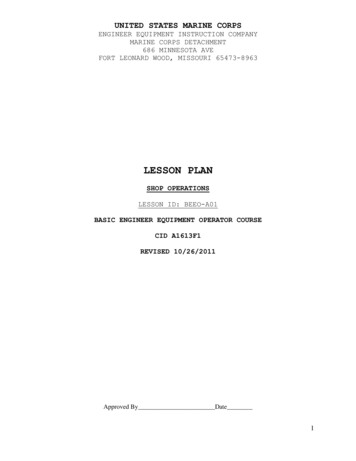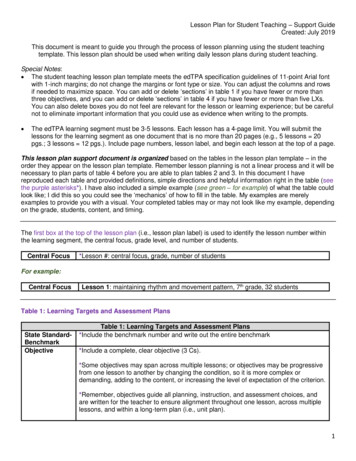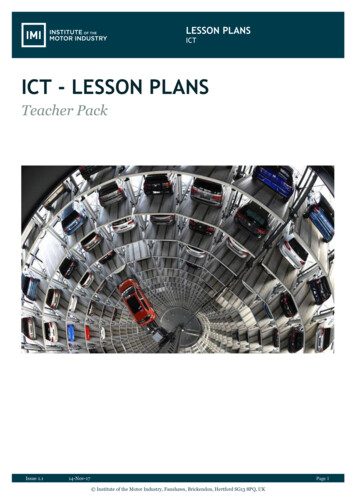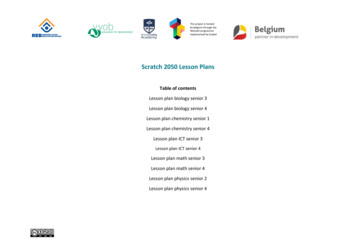
Transcription
UNITED STATES MARINE CORPSENGINEER EQUIPMENT INSTRUCTION COMPANYMARINE CORPS DETACHMENT686 MINNESOTA AVEFORT LEONARD WOOD, MISSOURI 65473-8963LESSON PLANSHOP OPERATIONSLESSON ID: BEEO-A01BASIC ENGINEER EQUIPMENT OPERATOR COURSECID A1613F1REVISED 10/26/2011Approved By Date1
(ON SLIDE #1,2)INTRODUCTION:(15MIN)1. GAIN ATTENTION. During this week of instruction you will beintroduced to the items that an operator will come into contactwith on a daily basis while completing his/her mission as afleet Marine, heavy equipment operator.(ON SLIDE #3)2. OVERVIEW. This week will be discussing engineer groundequipment records and forms, tools, materials, and engineerequipment that pertain to being a 1345.(ON SLIDE #4, 5, 6, 7, 8, 9)3.LEARNING OBJECTIVES.Instructor NoteHave the students read the Learning Objectives in their StudentOutline.a.TERMINAL LEARNING OBJECTIVE.(1)b.Provided references, facilities, forms, personnel,tools and engineer equipment, conduct shopoperations to maintain unit readiness withoutinjury to personnel or damage to equipment. (1345ADMN-1002)ENABLING LEARNING OBJECTIVES.(1)Given technical manual short titles, and withoutthe aid of reference, identify the four elements ofa short title per MCO P4790.2C. (1345-ADMN-1002a)(2)With the aid of reference, identify lubricationorders utilized in the maintenance and operation ofengineer equipment per TM-09135C-OR/A. (1345-ADMN1002b)(3)Without the aid of reference, identify the levelsof maintenance per MCO P4790.2C. (1345-ADMN-1002c)(4)Without the aid of reference, identify petroleum,oils, and lubricants (POL) utilized in the2
maintenance and operation of engineer equipment perthe Student handout. (1345-ADMN-1002d)(5)Without the aid of reference, identify toolsutilized in the maintenance and operation ofengineer equipment per the SL-3-11825A. (1345-ADMN1002e)(6)Without the aid of reference, select the correctrecords and forms per the TM 4700-15/1 . (1345ADMN-1002f)(7)Without the aid of reference, identify the levelsof operational risk management per the MCO 3500.27.(1345-ADMN-1002g)(ON SLIDE #10,#11)4. METHOD/MEDIA. This program of instruction will be taught bythe informal lecture method, aided by a detailed outline,computer generated slides, you’re student outline and applicableforms and training aids.Instructor NoteExplain Instructional Rating Forms to the students.(ON SLIDE #12)5. EVALUATION. On the fifth training day there will be a 25question written performance examination utilizing a lubricationorder.(ON SLIDE #13)6. SAFETY/CEASE TRAINING (CT) BRIEF. In case of fire make yourway out the closet exit and get in formation 200 feet from thebuilding, get accountability and wait for further instruction.In case of inclement weather stay seated in the classroom andwait for further instruction.TRANSITION: Now that you know what will be taught, how it willbe taught and how you will be evaluated, are there any questionson what has been covered to this point? If not, let’s move on totechnical manuals.3
BODY:(34HRS 45 MIN)(ON SLIDE #14,15)1.TECHNICAL MANUALS.(2HRS)(ON SLIDE #16)a.Purpose.(1)Technical manuals are designed by the military andused to provide general knowledge ofspecifications, characteristics, capabilities,maintenance, emergency operations, operation, andsafety practices.Instructor NoteHave students take out their TM and follow along with thecomputer aided slides.b.Cover Layout.(ON SLIDE #17)(1) Type of Publication.(a)TM’s take many forms. An item of engineerequipment may have five or more manualsassociated with it. Operator’s manual,maintenance procedures, parts catalogs etc.Having the type printed on the cover will allowthe individual Marine to narrow his/her searchfor the appropriate manual needed.(ON SLIDE #18)(2) Long Title.(a)The long title gives the equipment nomenclatureor the title for a given manual.(ON SLIDE #19)(3) Model Designation.4
(a)When a new model of an existing item ofengineer equipment is introduced a new TM maybe issued in lieu of a change to the existingTM.INTERIM TRANSITION: So far we have talked about types ofpublications, the Long Title and what a Model Designation is.Are there any questions? Everyone take a ten minute break.(ON SLIDE #20)(BREAK – 10 Min)INTERIM TRANSITION: Did anyone think of any questions during thebreak? If not let’s talk about the remainder of the CoverLayout.(ON SLIDE #21)(4) National Stock Number.(a)A National Stock Number is simply the officiallabel applied to an item of supply that isrepeatedly procured, stocked, stored, issued,and used throughout the federal supply system.(ON SLIDE #22)(5) Date.(a)Date the publication came into service.(ON SLIDE #23)(6) Short Title.(ON SLIDE #24,25,26,27,28,29)(a)TM 09135B–24/2.1.A short title can be broken into 5 parts.a. Characters (1-2) abbreviate the type ofmanual. In the above example, TMindicates Technical Manual.b. Characters (3-7) When discussing theTechnical Manual of an item of engineerequipment indicate the equipmentidentification number(ID).5
c. Character (8) indicates the modelpertaining to ID number (3-7).d. Characters (9-10) indicate the echelons ofmaintenance for which the TM has beenwritten.e. Character (11) indicates the manual volumenumber.TRANSITION: Thus far, we’ve discussed the characteristics oftechnical manuals. Are there any questions on what we’ve coveredto this point? If not I have a question for you, QUESTION:What does a TM provide to the operator? ANSWER: Generalknowledge of specifications, characteristics, capabilities,maintenance, emergency operations, operation, and safetypractices. Let’s take a break and then we will move on and talkabout the levels of maintenance.(ON SLIDE #30)(BREAK – 10 Min)TRANSITION: Did anyone think of any questions during the break?If not let’s talk about the levels of maintenance.(ON SLIDE #31,32,33)2.Levels of Maintenance.(1HR)Instructor NoteDiscuss previous classifications of maintenance as it refers tothe echelons of maintenance. This is how maintenance was brokendown in the past, first, second, third, fourth, and fifthechelons. Now it is levels of maintenance.(ON SLIDE #34)a.Organizational.(1)The Organizational level of maintenance is themaintenance performed by the trainedoperator/maintainer on the unit’s assignedequipment. Generally this consist of limitedaction by the operator and maintainer to include6
cleaning, inspecting, preserving, lubricating,adjusting, and testing, as well as replacing parts,minor assemblies and subassemblies as unit missiondictates and as defined by operator/maintainer orcrew military occupational specialty (MOS)individual training standards(ITS).(ON SLIDE #35)b.Intermediate.(1)The Intermediate level of maintenance ismaintenance actions performed by specialty trainedpersonnel normally in support of usingorganizations. This level of maintenance usuallyconsists of calibration, repair or replacement ofunserviceable parts, components or assemblies andalso may consist of the emergency manufacture ofnon-available parts. Intermediate maintenanceactivities provide technical assistance and contactteam support to using organizations.(ON SLIDE #36,37)c.Depot.(1)The Depot level of maintenance is maintenanceperformed on material requiring major overhaul orcomplete rebuild of parts, subassemblies,assemblies or end items to include the manufactureof parts, modifications, testing and reclamation asrequired. Depot maintenance serves to supportlower categories of maintenance by providingtechnical assistance and performing maintenancebeyond their responsibility. Depot maintenanceprovides stocks of serviceable equipment by usingmore extensive facilities for repair than areavailable in lower level maintenance activities.TRANSITION: Thus far, we’ve discussed the levels ofmaintenance. Are there any questions on what we’ve covered tothis point? If not I have a question for you, QUESTION: Whatare the three levels of maintenance? ANSWER: Organizational,Intermediate, and Depot. QUESTION: What level of maintenancedoes an operator fall under? ANSWER: Organizational. Let’stake a ten minute break and then we will talk about lubricationorders.7
(ON SLIDE #38)(BREAK – 10 Min)TRANSITION: Did anyone think of any questions during the break?If not let’s talk about lubrication orders.(ON SLIDE #39,40,41, 42)3.Lubrication Order. (2HRS)Instructor NoteHave students take out their LO and follow along with thecomputer aided slides. As you progress further into theLubrication Order have the students locate certain items thatare located on the LO. Have them tell you what interval theyfall under, what type of service is required and how manyservice points pertain to that item. Also, ensure you have thestudent flip the LO over and explain to them the difference intypes of viscosities used as it pertains to temperatures aboveand below 32 degrees F.a. A Lubrication Order (LO) is used by the operator tocomplete all applicable organizational level equipmentlubrication.(ON SLIDE #43)(1)Interval. This is the frequency in which the itemis maintained.(2)Item. This is the item on the equipment, which isto be maintained.(3)Maintenance points. This is the number of placeswhere the listed item can be found.INTERIM TRANSITION: So far we have talked about Intervals,Items and Maintenance Points. Are there any questions? Everyonetake a ten minute break.(ON SLIDE #44)(BREAK – 10 Min)8
INTERIM TRANSITION: Did anyone think of any questions during thebreak? If not let’s move on and talk about what else the LOcontains.(ON SLIDE #45,46,47,48)(4)Description. This tells the operator the requiredmaintenance action.(5)Material. This tells the operator what material, ifany, is required for a particular item.(6)Recommended lubricants. This area tells theoperator the lubricants required to completePreventative Maintenance Checks and Services orPMCS on that particular piece of equipment.TRANSITION: Thus far, we’ve discussed lubrication orders, aswell as their utilization. Are there any questions on whatwe’ve covered to this point? If not, I have a question for you.QUESTION: LO’s give the operator what important information?ANSWER: Interval, Item, Maintenance points, Description,Material, and Recommended lubricants. Let’s take a ten minutebreak and then we will talk about the common POL’s utilize inour equipment as well as who is responsible for them.(ON SLIDE #49)(BREAK – 10 Min)TRANSITION: Did anyone think of any questions during the break?If not let’s talk about POL.(ON SLIDE #50,51,52,53,54)4.PETROLEUM, OIL, AND LUBRICANTS (POL). (2HRS)a. A substance, often a liquid, introduced between twomoving surfaces to reduce the friction between them, improvingefficiency and reducing wear. They may also have the function ofdissolving or transporting foreign particles and distributingheat.b. Lubricating oils have many differing measurableproperties. The most common classification is based onviscosity. Viscosity can be perceived as a liquid’s resistanceto flow or its “Thickness”. For example a fluid labeled 10w will9
be “thinner” than a fluid labeled 70w. We also utilize multiviscosity oils such as 15W40. What this means is that theviscosity, or thickness of this oil is 15 but has an additive init which causes the oil to thicken as it heats up. When the oilreaches operating temperature it will thicken to a viscosity of40.(ON SLIDE #55,56)(1) Operator Responsibilities.(a)The Operator is ultimately responsible for theproper lubrication of his/her assigned item(s)of engineer equipment. The operator will beheld fully accountable and responsible for anyand all malfunctions or damage caused to anitem of engineer equipment do to operatorignorance, neglect, negligence or improperPMCS.(ON SLIDE #57,58,59,60,61,62)(2) Oil, Engine (OE).(a)Lubricates internal moving parts, stopscorrosion, dissolves contaminants, improvessealing, and removes engine heat. Without theproper amount of OE the motor will rapidlydeteriorate and destroy itself.(b)OE 15w40 is the most commonly used crankcaselubricant for diesel engine driven engineerequipment. Depending on conditions other OEmay be recommended by the original equipmentmanufacturer. Read and understand theorganizational level technical manual, as wellas the lubrication order before adding orrefilling the engine crankcase with lubricant.(c)OE is packaged in containers varying between 1quart and 55 gallons. The type and viscosityof the lubricant will be fixed to thecontainer.Instructor Note10
Throughout the POI draw the students’ attention to the labelingof each item of POL presented, in this case a 5 gallon containerof OE 15w40 labeled OE/HDO 15/40.(ON SLIDE #63,64)(3) Hydraulic Oil (HDO).(a)Transfers engine power to operate the hydrauliccylinders and motors used in engineerequipment.(b)HDO 10w is the most commonly used hydraulicfluid in engineer equipment. Depending onconditions other HDO may be recommended by theoriginal equipment manufacturer. Read andunderstand the organizational level technicalmanual, as well as the lubrication order beforeadding or refilling the hydraulic system withfluid.(c)HDO is packaged in containers varying between 5and 55 gallons. The type and viscosity of thelubricant will be fixed to the container.INTERIM TRANSITION: So far we have talked about OE and HDO. Arethere any questions? Everyone take a ten minute break.(ON SLIDE #65)(BREAK – 10 Min)INTERIM TRANSITION: Did anyone think of any questions during thebreak? If not let’s talk about Transmission Fluid.(ON SLIDE #66,67,68)(4) Transmission Fluid.(a)A special hydraulic fluid sent under pressureby the transmission’s internal oil pump throughthe valve body to control the clutches and thebands in order to control the planetary gearsets inside the transmission.11
(b)Transmission fluid is unique to the operationalparameters and materials uses in constructionof an automatic transmission. A transmissionmay require anything from light hydraulic oilto a specialized synthetic fluid such asDextron V. Failure to utilize the appropriatefluid per manufacturer’s guidance will causeincreased wear and equipment failure.Instructor NoteInform the students not to confuse automatic transmission fluidwith gear oil found in most manual transmissions.(c)Transmission fluid is packaged in a similarform to HDO/OE and is made available in 1 quartcontainers through 55 gallon drums.(ON SLIDE #69,70,71,72,73)(5) Gear Oil (GO).(a)Lubricating oil made specifically for manualtransmissions, transfer cases, planetary gearhubs, and differentials. It is of a higherviscosity to better protect these assemblies.The high viscosity ensures transfer oflubricant throughout the gear train.(b)Common gear oils range in viscosity from 75w to140w depending on application. The mostcommonly utilized gear oil in engineerequipment is GO 80w90. Inshore you Read andunderstand the organizational level technicalmanual before adding or refilling any gearcase.(ON SLIDE #74,75,76,77)(6) Grease Artillery Automotive (GAA).(a)A thick viscous substance used to lubricatemetal on metal contact reducing wear oncomponents.12
(b)GAA is the primary grease used externally onequipment pivot points such as the pivot pointsfound on the boom (arm) of an excavator.However GAA is not a suitable packing for wheelbearings or other high load applications.(c)GAA is packaged in pale form or individualtubes.(ON SLIDE#78,79,80,81,82,83)(7) Antifreeze.(a)A substance containing ethylene glycol which isadded to the water in a radiator to reduce thefreezing point and raise the fluid’s boilingpoint.(b)In most climates a 50/50 mix of antifreeze andwater in recommended for use in engineerequipment. The operator is responsible formixing the antifreeze to the correct ratiobefore adding it to the item of equipmentunless the antifreeze packaging indicates “PreMixed” or “ready to use”.(ON SLIDE #84,85)(c)Extended Life Coolants may be recommended bythe equipment manufacturer. It providesimproved heat transfer due to metal corrosionprotection. ELC must not be contaminated withother coolants or fluids and not diluted withwater. The chemical balance remains stableover a long life cycle.Interim Transition: Thus far we have discussed what a lubricantis, and who is responsible for the proper application. Also wehave touched on the most commonly utilized items of POL andthere uses. Are there any questions on what we’ve covered tothis point? Let’s take a ten minute break.(ON SLIDE #86)(BREAK - 10 MIN)Interim Transition: Did anyone think of any questions while onbreak? Let’s start the demonstration.13
Instructors NoteAt this time take the class to the MHE phase POL shed for ademonstration.(ON SLIDE #87)DEMONSTRATION. The purpose of this demonstration is to give thestudents the understanding of the POL’s contained in the POLshed, as well as the proper care, use, identification, clean-upand storage of POL’s. This demonstration should take 2.5 hours.The student instructor ratio is, 12:2.STUDENT ROLE: Observe the demonstration. Students need to be ina school circle around the POL shed in order to view theinstructor’s demonstration.INSTRUCTOR ROLE: Demonstrate the proper identification, use,care, clean-up and storage of all POL’s in the POL shed.1. Safety Brief: There are no safety concerns during thisdemonstration.2. Supervision and Guidance: The instructor is to demonstratethe proper identification of all lubricants contained in the POLshed, how to utilize proper containers (1 quart oil cans),(anti-freeze jug), hazardous material clean-up, returninglubrication containers to their proper place inside the POLshed. Answer any questions that may arise during thedemonstration from the students.3. Debrief: Allow students the opportunity to comment on whatthey observed. Provide overall feedback, guidance on anymisconceptions, and review the learning points of thedemonstration. Ask the students if there are any questionsabout the demonstration.Instructor NoteAt this time take the class back to the classroom.(BREAK - 10 MIN)Transition: We have just finished the demonstration of what aPOL shed looks like and covered some of the POL’s that weutilize in our engineer equipment. Are there any questions overanything that we just covered? If not I have a question foryou, QUESTION: What can the fluid in a container marked OE/HDO10 be utilized for? ANSWER: The fluid can be utilized in acrank case or hydraulic system if recommended by TM or OEM.QUESTION: What is the purpose of greasing engineer equipment?14
ANSWER: Grease is used to reduce friction and prevent prematurewear. QUESTION: What are the benefits of using ELC versesordinary antifreeze? ANSWER: Long service life, reducedcorrosion, and improved heat transfer. Let’s move on and talkabout some of the common tools that we utilize when conductingPMCS on our equipment.(ON SLIDE #88,89)5.TOOLS. (1HR)Instructor NoteAs you begin to explain the GMT and B.O.B make sure to explainthat these are not the only tool kits that we utilize. Providesome insight as too where they will get the tools needed toconduct PMCS and emphasize the importance of whom is responsiblefor a certain tool or tool kit once they have signed for it.Also explain to them the importance of reporting when a tool hasbeen broken and/or lost and what to do in the event that one ofthe two happens to them.(ON SLIDE #90)a.General Mechanic’s Toolbox.(1)The general mechanic’s toolbox is a set of toolsutilized by a mechanic or operator to performorganizational level maintenance on items ofengineer equipment.(2)The individual who signs for the tools is directlyresponsible for the accountability andserviceability of the loaned tools.(ON SLIDE #91)b.Basic Operator’s Bag.(1)The basic operator’s bag, or B.O.B, is a set oftools utilized by an operator to perform preventivemaintenance on items of engineer equipment.(2)The individual who sign’s for the bag is directlyresponsible for the accountability and15
serviceability of the tools contained in the basicoperator’s bag.Interim Transition: Thus far we have discussed theidentification and utilization of the tools used to maintainengineer equipment. Are there any questions on what we’vecovered to this point? Let’s take a ten minute break and thenwe will move on to the demonstration portion of the GMT and theB.O.B.(ON SLIDE #92)(10 min break)Instructor NoteAt this time gather the class around the GMTB and BOB.(ON SLIDE #93,94,95,96)DEMONSTRATION. The purpose of this demonstration is to give thestudents the understanding of how to properly identify and theproper use of tools within the GMTK and BOB. This demonstrationshould take 2.5 hours. The student instructor ratio is, 12:1.STUDENT ROLE: Observe the demonstration. Students need to moveto a school circle around the instructor in order to observe thedemonstration. Allow students to handle items if they wish.INSTRUCTOR ROLE: Demonstrate how to identify the type, and theprimary function of the tools contained in the GMTK and BOB.1. Safety Brief: Not applicable due to classroom demonstration.2. Supervision and Guidance: The instructor is to demonstratethe proper identification and nomenclature of all toolscontained in the GMTK and BOB. The instructor will demonstrateeach tools purpose and demonstrate proper care of tools. Allowthe students to handle the tools to better understand theircharacteristics. The instructor will answer any questions thatmay arise during the demonstration from the instructor.3. Debrief: Allow students the opportunity to comment on whatthey observed. Provide overall feedback, guidance on anymisconceptions, and review the learning points of thedemonstration. Ask the students if there are any questionsabout the demonstration.Transition: Now that we have finished our demonstration of someof the basic tools that are utilized by engineer equipment16
operators when conducting PMCS on engineer equipment are thereany questions before we move on?If not I have a question foryou, QUESTION: True or false; General Mechanic’s toolboxes areonly issued to mechanics? ANSWER: False, operators requireaccess IOT complete their assigned missions. QUESTION: Who isresponsible for a given set of tools? ANSWER: The Marine thatsigned for them. Let’s go ahead and take a ten minute break.(ON SLIDE #97)(BREAK - 10 MIN)Transition: If there are no more questions concerning tools wewill talk about the NAVMC 10523.(ON SLIDE #98,99,100,101,102)6.NAVMC 10523, ENGINEER EQUIPMENT OPERATIONAL RECORD.(4HRS)(ON SLIDE #103 - 112)a.Purpose.(1)The purpose of form NAVMC 10523 is to provide theoperator of an item of equipment with the authorityto operate it on an assigned mission. The NAVMC10523 is utilized on daily missions not exceeding a24 hour time period.(2)The NAVMC 10523 provides the operator with achecklist for conducting daily preventivemaintenance checks and services (PMCS).(3)The NAVMC 10523 provides a means of recordingmileage and hours for equipment operation so thatPMCS may be scheduled. It also allows you torecord the amount of petroleum, oil, andlubrications (POL’s) that you used.(4)The NAVMC 10523 need not be prepared on equipmentwhen an ERO/SRO has been submitted and equipment isoperated from local equipment pool area to themaintenance shop.(a) An ERO/SRO is a repair order that is submittedto your maintenance section in order to allow17
the maintenance shop to perform scheduled PMCSor to repair your equipment.Instructor NoteHave the student get out their NAVMC 10523.(ON SLIDE #113,114)b. Dispatcher Responsibilities. The Dispatcher is anyMarine from your shop assigned in writing by your OIC to performthe duties as the dispatcher. The dispatcher is responsible fortracking all missions and assigning operators and equipment tosupport missions that are requested. Other responsibilities ofthe dispatcher are to keep record jackets up to date and toschedule equipment PM’s with your maintenance section.(ON SLIDE #115)(1)In the “DATE” block, the dispatcher enters the datethe equipment is dispatched.(ON SLIDE #116)(2)In the “EQUIPMENT” block, the dispatcher enters theequipment's nomenclature or type of equipment thatis to be used on your assigned mission.(ON SLIDE #117)(3)In the “USMC OR SERIAL NO” block, the dispatcherenters the equipment's six digit USMC serialnumber.(ON SLIDE #118)(4)In the “ORGANIZATION” block, the dispatcher entersthe noun name of the unit that is responsible forthe equipment.(ON SLIDE #119)(5)In the “1ST or 2ND OPERATOR” block for theappropriate 1ST or 2ND operator, the dispatcherenters the operator's name as listed on theoperator's license (OF-346).(a) The OF-346 is you operator’s license. Thisdocument lists all of the equipment that you18
are licensed to operate. The OF-346 will becarried with you at all times while operatingheavy equipment.(ON SLIDE #120)(6)In the “TIME OUT” block for the appropriate 1ST or2ND operator, the dispatcher enters the time thatthe equipment is dispatched.(ON SLIDE #121)(7)In the “DISPATCHER'S SIGNATURE” block for theappropriate 1ST or 2ND operator, the dispatchersigns his/her name. The NAVMC 10523 is not validwithout the dispatcher’s signature.(ON SLIDE #122)(8)In the “REPORT TO” block for the appropriate lST or2ND operator, the dispatcher enters the locationthat the operator is to report.(ON SLIDE #123)(9)In the “OIL CHANGE HOUR/MILE DUE” block, thedispatcher enters the hours/miles the next oilchange is required. This block may be left blankwhen the equipment is enrolled in an oil analysisprogram. (Unit SOP will dictate).(10) In the “OIL CHANGE HOUR/MILE COMPLETED” block, thedispatcher enters the hours/miles the last oilchange was completed. This block may be left blankwhen the equipment is enrolled in an oil analysisprogram. (Unit SOP will dictate).(11) In the “LUBRICATION HOUR/MILE DUE” block, thedispatcher enters the hours/miles the nextlubrication is required.(12) In the “LUBRICATION HOUR/MILE COMPLETED” block, thedispatcher enters the hours/miles the lastlubrication was completed.19
(13) In the “PM SERVICE TYPE PM DUE” block, thedispatcher enters the type of second echelon ofmaintenance or higher PMCS that is due.(14) In the “PM SERVICE HOUR/MILE DUE” block, thedispatcher enters the hours/miles a second echelonof maintenance or higher PMCS is due per thecommodity section of TM 4700-15/1 .(15) In the “PM SERVICE HOUR/MILE COMPLETED” block, thedispatcher enters the hours/miles when the lastsecond echelon of maintenance or higher PMCS wascompleted.(16) In the “OPERATION BEFORE” blocks, the dispatcherenters the legend as listed on the NAVMC 10524indicating operator before-operation PMCS.(17) In the “OPERATION DURING” blocks, the dispatcherenters the legend as listed on the NAVMC 10524indicating operator during-operation PMCS.(18) In the “OPERATION AFTER” blocks, the dispatcherenters the legend as listed on the NAVMC 10524indicating operator after-operation PMCS.INTERIM TRANSITION: So far we have talked about the purpose ofthe NAVMC 10523 and the Dispatchers responsibilities. Are thereany questions? Everyone take a ten minute break.(ON SLIDE #124)(BREAK – 10 Min)INTERIM TRANSITION: Did anyone think of any questions during thebreak? If not let’s talk about the Operators Responsibilities.(ON SLIDE #125,126)c.Operator Responsibilities.(ON SLIDE #127 -151)(1)Before Operations.(a) In the “HOURS OR MILES START” block for theappropriate 1ST or 2ND operator, the operatorenters the hours/miles indicated on theequipment's equipment operational time20
indicator before leaving the equipment pool.Hours are recorded as shown on the hour meterin whole numbers. You do not round up or downwhen recording hours. Leave this block blankwhen the equipment does not have an equipmentoperational time indicator.(b) In each “ITEM” block for the “OPERATION BEFORE”,the operator initials verifying that beforeoperation daily PMCS, as indicated in theLegend for Marking and in the appropriate TM,is completed before leaving the equipment poolwith the equipment.(ON SLIDE # 152-159)(2)During Operations.(a) In each “ITEM” block for the “OPERATION DURING”,the operator's initials verifying that duringoperation daily PMCS, as indicated in theLegend for Marking and in the appropriate TM,is completed during equipment operation.INTERIM TRANSITION: So far we have talked about the how we fillout our before and during operations columns. Are there anyquestions? Everyone take a ten minute break.(ON SLIDE #160)(BREAK – 10 Min)INTERIM TRANSITION: Did anyone think of any questions during thebreak? If not let’s talk about the after operations column.(ON SLIDE #161)(3)After Operations.(ON SLIDE #162)(a) In the “RELEASED BY” block for the appropriatelST or 2ND operator, the operator obtains asignature from the person whom you reportedto. This signature authorizes the operator toreturn to the equipment pool. When the21
operator cannot obtain a “RELEASED BY”signature the Equipment Officer, EquipmentChief, or Lot Foreman may sign this block.(ON SLIDE #163-167)(b) In each “ITEM” block for the “OPERATION AFTER”,the operator initials verifying that afteroperation daily PMCS, as indicated in theLegend for Marking and in the appropriate TM,is completed before returning the NAVMC 10523to the dispatcher.(ON SLIDE #168)(c) In the “TIME IN” block for the appropriate lSTor 2ND operator, the operator enters the timethe equipment returned to the equipment pool.(ON SLIDE #169)(d) In the “TIME TOTAL” block for the appropriatelST or 2ND operator, the operator enters thetotal time the equipment was dispatched. Thisis the TIME IN block minus the TIME OUT block.(ON SLIDE #170)(e) In the “HOURS OR MILES STOP” block for theappropriate 1ST or 2ND operator, the operatorenters the hours/miles indicated on theequipment's operational time indicator or hourmeter before returning NAVMC 10523 to thedispatcher. Leave this block blank when theequipment does not have an equipmentoperational time indicator.(f) In the “HOURS OR MILES TOTAL” block for theappropriate 1ST or 2ND operator, the operatorenters the total hours/mi
Discuss previous classifications of maintenance as it refers to the echelons of maintenance. This is how maintenance was broken down in the past, first, second, third, fourth, and fifth echelons. Now it is levels of maintenance. (ON SLIDE #34) a. Organizational. (1) The Organizational level of maintenance is the maintenance performed by the trained











